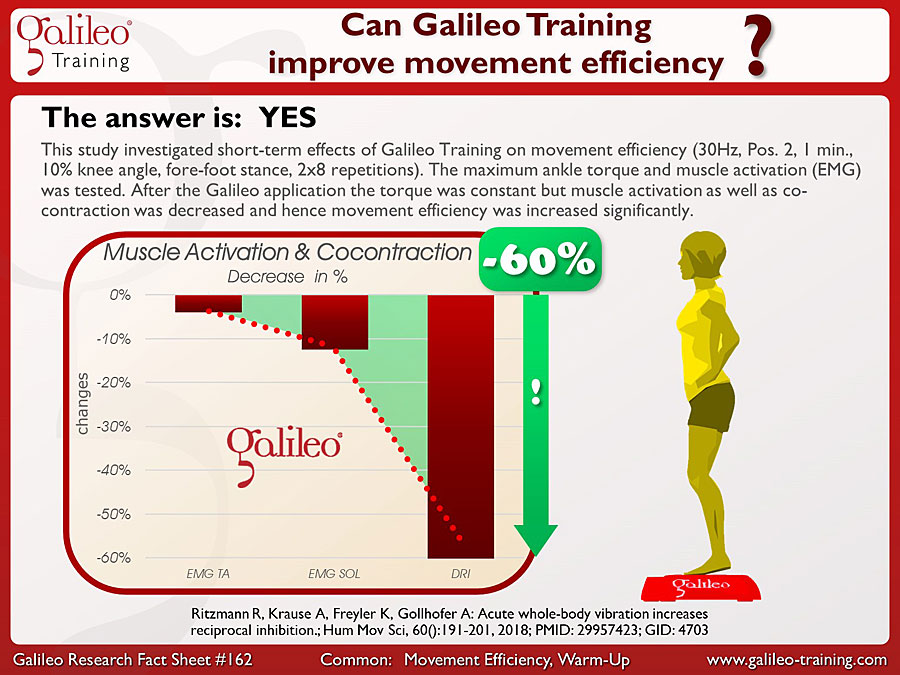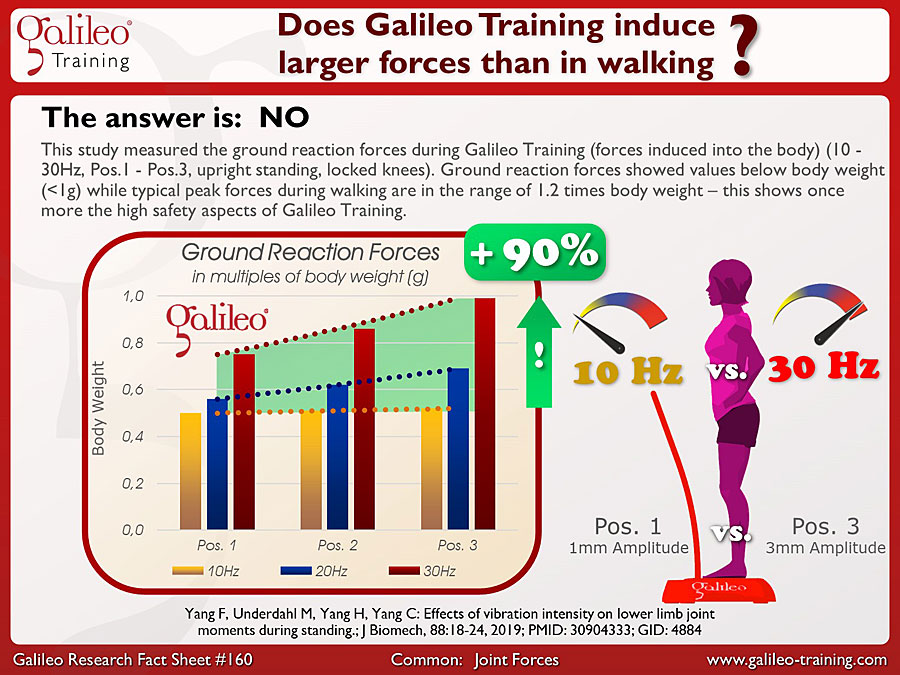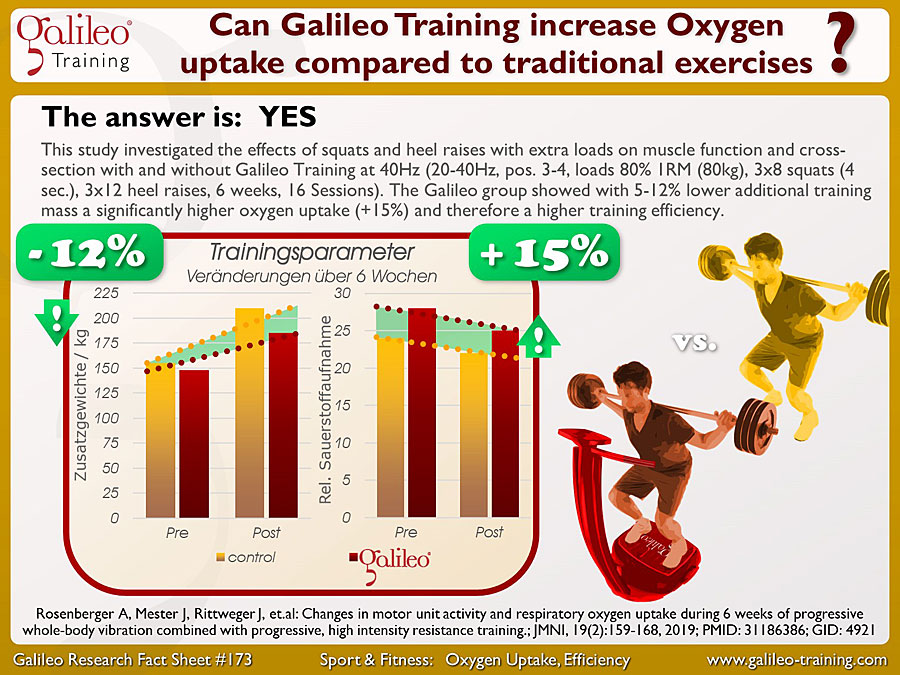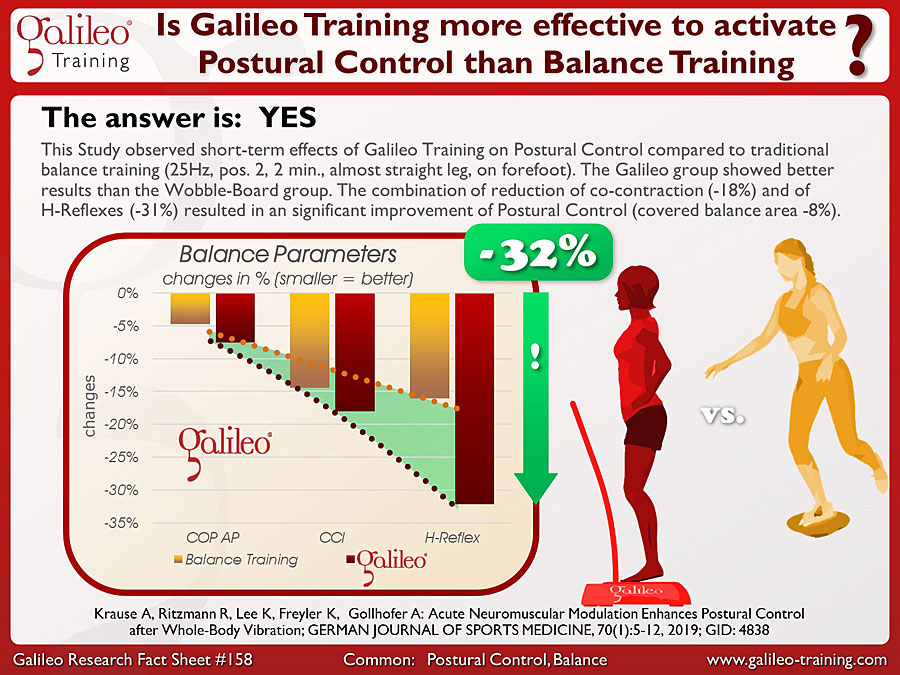Tag Archives: MechanoStimulation
This study investigated short-term effects of Galileo Training on movement efficiency (30Hz, Pos. 2, 1 min., 10% knee angle, fore-foot stance, 2x8 repetitions). The maximum ankle torque and muscle activation (EMG) was tested. After the Galileo application the torque was constant but muscle activation as well as co-contraction was decreased and hence movement efficiency was increased significantly...
Galileo Research Facts No. 161: Can Galileo Therapy improve muscle function in Spinal Muscle Atrophy (SMA)?
This study investigated the effects of Galileo Therapy in Spinal Muscle Atrophy (SMA, type II, III, IIIa, age 2-7) (Cologne Concept: 3x3 minutes, 10 session/week, 26 weeks). Galileo Therapy showed significant improvements in muscle function in Gross Motor Function Test (GMFM-66, +4%) and Hammersmith Functional Mobility Scale (HFMS, +9,5%). The following 6 months of standard therapy did not show further significant improvements...
Galileo Research Facts No. 160: Does Galileo Training induce larger forces than in walking?
This study measured the ground reaction forces during Galileo Training (forces induced into the body) (10 - 30Hz, Pos.1 - Pos.3, upright standing, locked knees). Ground reaction forces showed values below body weight (<1g) while typical peak forces during walking are in the range of 1.2 times body weight – this shows once more the high safety aspects of Galileo Training...
Galileo Research Facts No. 173: Can Galileo Training increase Oxygen uptake compared to traditional exercises?
This study investigated the effects of squats and heel raises with extra loads on muscle function and cross-section with and without Galileo Training at 40Hz (20-40Hz, pos. 3-4, loads 80% 1RM (80kg), 3x8 squats (4 sec.), 3x12 heel raises, 6 weeks, 16 Sessions). The Galileo group showed with 5-12% lower additional training mass a significantly higher oxygen uptake (+15%) and therefore a higher training efficiency...
Galileo Research Facts No. 159: Can Galileo Therapy be used even under intense Chemotherapy in Leukemia?
This safety study investigated the effects of Galileo Therapy during intense chemotherapy in Leukemia. Galileo Therapy was compared to cycling ergometer training (20 min., 18-25Hz, pos. 3-4, 120° squat, 3/week, 2 weeks). The Galileo group showed significant muscle function improvements compared to the ergometer group with in Chair-rise power (+4%), jump height (+12%) as well as timed up & go test (TUG, +19%)...
Galileo Research Facts No. 158: Is Galileo Training more effective to activate Postural Control than Balance Training?
This Study observed short-term effects of Galileo Training on Postural Control compared to traditional balance training (25Hz, pos. 2, 2 min., almost straight leg, on forefoot). The Galileo group showed better results than the Wobble-Board group. The combination of reduction of co-contraction (-18%) and of H-Reflexes (-31%) resulted in an significant improvement of Postural Control (covered balance area -8%)...
Galileo Research Facts No. 157: Can Galileo Therapy improve muscle function and gait speed in children with Ataxia?
This study shows the effect of Galileo Therapy (Cologne Concept: 3x3 minutes, 10 session/week, 26 weeks) in Ataxia patients (3-14 years, 2 groups: progressive and non-progressive). Both Galileo groups show significant improvements in GRMF66 (+7%), gait speed (+12%), 1MWT (+41%). In the following 6 months with standard therapy there was no additional relevant improvement in the parameters...
Galileo Research Facts No. 156: Can Galileo Therapy increase Bone Mass?
This study investigated possible positive effects of Hypoxia (simulated high-altitude training) on Galileo Therapy for the increase of bone mass in older individuals (age: 65-77). Three groups were used (Control, Galileo with & without Hypoxia, +5min. Ergometer warmup, 12.5Hz, 120° squat, pos. 2, 4x30sec, 2/week, 18 weeks). Both Galileo groups show significant improvements of bone mass compared with the control group...
Galileo Research Facts No. 155: Can Galileo Therapy help COVID-19 patients for therapy and physical rehab?
The WAVex (World Association of Vibration Exercise Experts) Panel recommends the use of Galileo Therapy for COVID-19 patients for therapy and physical rehab. Background for the recommendation are the results of 36 international comparable studies – more than half of them using Galileo devices, including the import ones concerning the use in ICU, COPD, CP, Parkinson and allogeneic hematopoietic cell transplantation...
Galileo Research Facts No. 154: Can Galileo Therapy be used safely for patients in Intensive Care Units (ICU)?
This study investigated effects and safety of Galileo application for mechanically ventilated patients in intensive care unit (UCI) with an expected stay of 7 days. A Galileo Med 15 was mounted directly to the ICU bed (exercises in lying, 3x3 Min., 24Hz, 20° knee flexion). The results showed significant positive muscular and cardiovascular effects and an improved muscle metabolism without negative side-effects...









